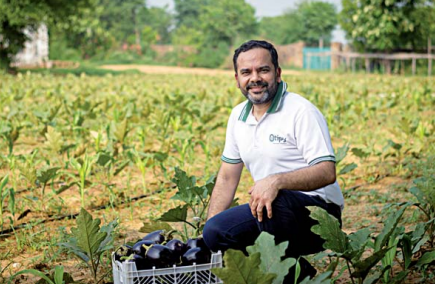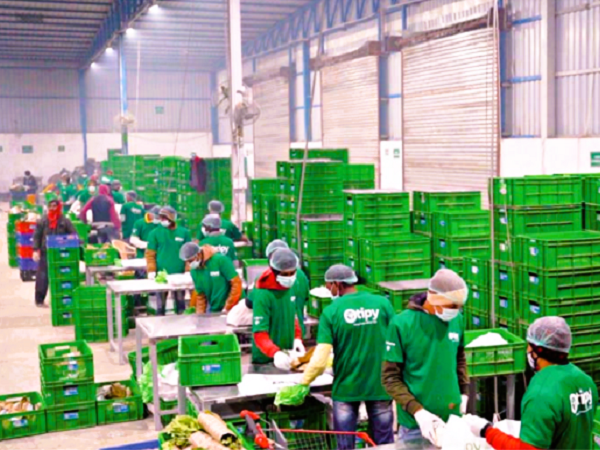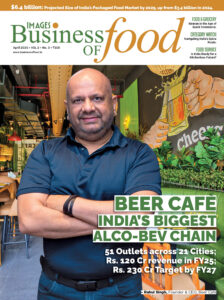Started in 2020, Otipy was launched as an online fresh fruits and vegetables’ selling app with the aim to connect end-consumers with farmers through a community of resellers who handle the last-mile delivery of fresh farm products.
Thanks to its super-fast and super-agile supply chain, which significantly cuts down on the time it takes for the produce to reach the consumer after it is harvested, Otipy’s farm products boast of offering ‘best freshness, best quality, and best prices.’
Just few years into its operations, this online retailer has raced ahead to become India’s fastest growing community group-buying start-up for fresh farm produce with the gross revenue of Rs. 115 crore for the FY 23-24.
Otipy delivers fresh and chemical-free fruits and vegetables along with dairy. bakery and grocery products to over 5 lakh customers across Delhi-NCR, moving about 110-120 tonnes of fresh produce from the farms to its consumers every day. With time, Otipy hopes to become the largest organized retailer in the country for fresh fruits and vegetables, leaving behind even established behemoths in this space like Mother Dairy and Reliance Fresh.

For those of us used to the ways of quick commerce grocery, getting a product delivered to the doorstep within 10-20 minutes flat is now a matter of routine convenience and urban mundanity. But the switch flips for quick commerce players if a consumer wants a sack of farm-fresh cauliflowers or a bag of fresh ripe tomatoes at 7:00 in the morning! Even the fastest quick delivery whizkids will be left blushing in the face when fulfilling and delivering on orders for genuinely fresh fruits and vegetables at the crack of dawn.
Enter agritech start-up Otipy (operated by Crofarm Agriproducts Pvt. Ltd.), whose online app is optimized for quick delivery of fresh produce and other grocery items, and that too with the guarantee of freshness and at a more pocket-friendly price. Launched in 2020, Otipy has raced ahead to become India’s fastest growing community group-buying start-up for fresh farm produce with the gross revenue of Rs. 115 crore for the FY23-24.
Currently, Otipy moves about 110-120 tonnes of fresh produce from the farms to its consumers every day, which is higher than any other online retail player and second only to the daily tonnage moved by established fresh food retailers like Mother Dairy and Reliance Fresh. By the end of this year, Otipy hopes to sprint ahead of even these behemoths and become the largest organized retailer in the country for fresh fruits and vegetables
The parent company Crofarm was founded by Varun Khurana, 5 years ago, in 2016, as a B2B operations for the supply of fresh fruits and vegetables. Four years later, Khurana launched Otipy as the consumer arm of Crofarm. In the process, Otipy also became India’s first community group-buying platform for fresh produce and daily essentials.
About 80% of Otipy’s product basket comprises fresh fruits and vegetables; dairy and bakery products make for another 5%; and the remainder is taken up by standard grocery products. This online app is now the leader among all the other online retail players in the Delhi-NCR region for providing fresh fruit and vegetables, thanks to its super-fast supply chain operations. Today, Otipy delivers fresh and chemical-free fruits and vegetables along with dairy, bakery and grocery products to over 5 lakh customers across Delhi and other towns in the NCR like Noida, Ghaziabad, Gurgaon, Sonepat, Meerut, Bhiwadi, and Mumbai.
Since its launch, the wheels of business for Otipy has been spinning faster every passing day, validating its business model of quick and fast delivery with the guarantee of offering freshly harvested farm products that embody maximum freshness, better quality and come at a more attractive price.
From concept to a compelling business model
Before founding Otipy, Varun Khurana was the Chief Technology Officer at Grofers, now rechristened Blinkit. The stint helped him gain a good grasp of the intricacies involving online retail and specifically the grocery category, including the management of fresh fruits and vegetables.
‘‘My first business experience with fruits and vegetables was at Grofers where I experienced that the perishable nature of the produce makes the Fresh category very unique. Unlike traditional grocery items, stocking and retailing fruits and vegetables is a very risky proposition. After leaving Grofers, when I spent some time at the farms, I realized there were additional gaps in the supply chain from farm to consumers. Wastages are high for this category, which result in a high markup between the price that a farmer gets and what a consumer pays,” observes Khurana.
In order to understand the demand for farm-fresh products, get the skinny on consumer psyche and preferences when it comes to buying fresh fruits and vegetables, and know if Otipy’s business model and value proposition would resonate with consumers, Khurana decided to conduct a survey across consumers of farmfresh products on behalf of his company Otipy. Close to 2,000 individuals from across Delhi-NCR participated in the Otipy’s Survey on demand for fresh farm products and food wastage, with almost equal participation from men and women (49.48% male and 50.52% female) between different age groups of people from under 18 to above 50 years.
The survey revealed that given a choice, 90% of the people would opt for buying farm-fresh vegetables instead of getting stored food delivered from supermarkets and other vendors. The survey also revealed that almost 50% of people prefer not to consume refrigerated food and only 7.89% of people consume it frequently. As to the grocery shopping pattern of consumers, the results showed that a majority of buyers plan grocery shopping on alternate days (36.03%) or twice a week (36.45%) followed by 15.82% once a week.
Another interesting find was that close to 75% of consumers admit to wasting food on a daily or weekly basis, and close to 60% consume it the next day if it’s cooked food or give it away to animals if it is rotten fruits or vegetables. “Based on the findings of the survey, the optimism for our business model was further amplified. The proof of the pudding is that we have already become the biggest online supplier of fresh fruits and vegetables in Delhi-NCR. It has also reinforced our belief that consumers are switching to healthy eating habits and lifestyle and that one of the priorities of the new age consumer is to opt for fresh and refrain from refrigerated products, alongside their concern for minimal wastage of food,” remarks Khurana.
However, retailing fruits and vegetables has always been a problematic category and is fraught with challenges. Explaining this piece of the retailing puzzle, Khurana says: “Supply chain operations around conventional retail are mostly geared towards sourcing and storing the product. So, when a consumer orders a grocery product, very often that item is already available on the store shelf or is lying somewhere in the warehouse and they get delivered according to their scheduled time slot.
However, this part of the operation becomes counterintuitive when it comes to storing and retailing fresh fruits and veggies for the reason that these products are perishable and have a very limited shelf life. They keep degrading in quality every passing minute that they remain in the warehouse and by the time an order comes in and they get delivered, the quality of the produce has already seen a significant deterioration.”
Building a supply chain optimized for speed, freshness and quality
To get around the problem of the perishable nature of fruits and vegetables, Otipy has built a super-fast and super-agile supply chain, which significantly cuts down on the time it takes for the produce to reach the consumer after it is harvested. Thanks to its versatile supply chain, Otipy boasts of industry’s lowest wastage which, at 3%, that is 10x better than the conventional supply chain. Also, by leveraging its community leader model, Otipy operates at the industry’s lowest logistics cost — as low as Rs. 3/kg — from its warehouse to the consumer’s doorstep.
There are quite a few innovations that Otipy has built around its supply chain to meet its objective of offering ‘best freshness, best quality, and best prices’. To begin with, the entire gamut of operations is powered by a cutting edge predictive algorithm, which is optimized for maintaining the freshness parameter of the produce. Unlike in the quick commerce model where the product being ordered is already lying in a dark store, the produce is still at a farm when an Otipy customer makes an order on the app.
“Our prediction mechanism makes it possible for us to know that, say, there will be a total order for about 4 tons of cauliflower on a specific day. Based on this prediction, we accordingly make the arrangement for the produce to be harvested by the afternoon, get it lifted off the farm and transported to the warehouse by evening. Here, the produce is first quality-tested, picked, sorted, packaged and then dispatched for delivery, all in a matter of 4-6 hours. This way, by following up on our well-defined supply chain processes, we are able to align and bring about a parallelism, or a conjunction, between the transit time for the produce to reach the warehouse and the overall booking order time for that produce. Also, we are able to substantially shorten the time lag required for the produce to be harvested and delivered to the consumer,” says Khurana.
Other technological innovations embedded into Otipy’s supply chain include building both the software as well as the hardware required for full automation of the whole supply chain process In the quick commerce delivery model, the entire supply chain is designed and centred around providing convenience for the consumers. In order to deliver on the promise of 10-20 minute convenience, the cost of supply chain operations for the quick commerce convenience players is fundamentally higher. They need to run and operate dark stores with delivery boys positioned every 3-4 km along the geographies they serve to fulfill on the promise of delivering convenience,” says Khurana
Also, the quick commerce delivery model is not suited to products belonging to the fresh category. It’s a hugely challenging task to keep stocking fresh fruits and vegetables thoughout the day and keep delivering them as per the flow of orders. First, the quality and freshness of the products take a big hit and replenishments in the cases of stock-outs become a huge issue. Also, because of the perishable nature of fruits and vegetables, there is a lot of wastage with products going bad or losing their freshness
“Unlike the quick commerce players whose focus is on quick delivery once an order arrives, our focus is on optimizing the time between the harvest of the produce and the time of delivery so that there is no quality decay or degradation in the nutritional value of the produce. To realize this objective, we have worked on shortening our supply chain and making the turnaround time for the produce faster and quicker. This way, we have ensured that the produce reaches the consumers within just 12 hours from being harvested, allowing us to maintain the freshness of the produce,” says Khurana.
He adds: “We procure fruits and vegetables directly from farmers and then with the help of local community leaders that work with us as delivery partners/resellers, we do the doorstep delivery to the consumers. The idea is to deliver fresher, more nutritious and quality-resilient produce in the hands of the consumer.”
By funneling the produce through the supply chain in the fastest possible time, we are able to deliver produce that are not only fresh off the farm but also come packed with higher nutritional value. At the same time, our shorter supply change results in minimal wastage of the produce. As there is less wastage, we are able to save and earn more and are able to pass on the price benefits to our customers. This way, our consumer offerings not only come with better quality, they also enjoy a comparatively better pricing,” explains Khurana.
Due to the much lower rate of the wastage of products and thanks to the accrued savings, he says that the prices of Otipy farm products are about 15% lower compared with similar category products sold in the neighborhood stores and about 5-7% lower than the prices of similar products available at established supermarkets.
Leveraging the “reseller” model for cost efficiency
Otipy’s business model helps to connect end consumers to farmers through a community of resellers who handle the last-mile delivery of fresh produce. In fact, the whole concept of fast delivery of the produce with better quality and at a more competitive price is supported by Otipy’s “reseller” business model. To offer an analogy, think of how companies like Tupperware sell their products through their sales representatives who operate in their respective communities. Similarly, Otipy representatives, called resellers, induce consumers to download the app and the resellers are able to track the consumers as place orders on the Otipy app. The company then arranges to deliver the products to the resellers for distribution among the buyers.
“We don’t sell through delivery boys but through our resellers who often tend to be owners of small businesses. For instance, a typical Otipy reseller might be a lady running her own beauty parlor or a boutique with the help of 2-3 assistants or helping hands. Or someone might be a home chef whose home-cooked food has a good following within his neighborhood or a real-estate broker. These are the kinds of businesses that start not before 9-10 in the morning, which means that their owners have idle time and capacity on their hands early in the morning, which they can put to good commercial use by becoming our resellers. We offer about a 7% commission on the sales to our resellers, 70% of whom are female and, on average, a reseller makes about Rs. 15,000 a month. By recruiting these resellers, we are trying to make good economic use of their idle capacity in the morning hours in terms of labour and infrastructure and without impacting their regular activities and primary source of income,” says Khurana.
The number of resellers that Otipy employs keeps changing according to their performance and demand cycle of the platform. “In recent months, the numbers have touched 500+ but there is also a constant change and churn happening. We keep adding or pruning the numbers based on our requirements and according to their capabilities in growing the buyers’ base and meeting the growth targets. Those resellers who are not able to deliver on time or not able to expand their buyers’ pool are justifiably dropped and new replacements come in. We want to have resellers who want to stay with us in the long run by sharing our vision of creating a groundswell of goodwill and support for buying farm-fresh produce and spreading the message of freshness,” says Khurana.
Giving an example of the cost differential and wastage levels between quick commerce and reseller based delivery models, Khurana says: “In a quick commerce grocery delivery model, it takes anywhere between 20-25 minutes for a delivery boy to fulfill an order and come back to his base station; by this estimate, it can take about 2 hours to fulfill just 4-5 orders. In our case, our reseller fulfills 25-30 orders within a 2-hour time frame and s/he is able to do it just by utilizing their idle capacity in the morning. It’s thus a no-brainer that our supply chain model is perfectly optimized for cost-effectiveness. It’s also the reason why we are able to offer better prices to customers and that too without burning a hole in our own pocket. Also, in a conventional retail supply chain there is about 35% wastage of fresh fruits and vegetables whereas it’s only 3% in our model. This factor also allows us to offer a better pricing for the products to the consumers.”
Each Otipy reseller typically recieves 25-30 orders a day, from the buyers in his/her community. For speedier and more streamlined delivery, Otipy arranges its fleet management in a way that each of its carts can deliver to at least 4-5 resellers when making the rounds. “It takes not more than 2 hours every morning for our resellers to distribute the produce among their buyers, leaving them with sufficient time to pursue their other business and regular activities. At the same time, we are able to make good on our value proposition of delivering better-quality produce with better freshness and more affordable prices,” points out Khurana
Sourcing strategy with quality assurance
As with any retailing enterprise, sourcing is the primary backend operations for Otipy. For sourcing the farm products that it sells to end-consumers through resellers, Otipy works with over 20,000 farmers over the course of a year. These farmers are either part of farmer-producer organizations (FPOs) or are groups of individual farmers that the company refers to as “lead farmer” model. Under the lead-farmer model, the company works with groups of leading farmers who might have at least 6-8 acres of land under cultivation in a particular region.
After discussions and negotiations, Otipy enters into a broad arrangement with these farmers for the supply of a particular crop over the course of a season. “These arrangements are based on mutual trust but are not contractual or obligatory in a legal sense. Based on our data projections for various agri-produce, a broad arrangement is worked out with such lead farmers who are willing to supply a specific tonnage of the cultivated produce according to the prevailing price of the commodity,” informs Khurana, adding that the company pays them approximately 10% more than what they would get paid in the regular mandis. “Like our resellers, our farmers too have an additional incentive to supply us with superior grade farm produce because they get a fairer price for the product,” says Khurana.
The farmers are divided into groups and each group might have about a hundred farmers. During the course of a year, Otipy is engaged with some 200 farmer groups and at any point in time about such 100 farmer groups or some 10,000 farmers are actively engaged with the company for daily and seasonal supply of various farm products. Otipy’s arrangement with the farmer groups are spread across the country and across different geographies based on the seasonal demand for different agri products.
“We have a pan-India sourcing footprint with our farmer communities spread across different regions in the country. These include Nashik in Maharashtra for sourcing onion, grape, and pomegranate; Karnataka for green coconut; Ganganagar in Rajasthan for kinnow; and particular belts in Gujarat, Haryana and Himachal for various other seasonal farm products.” As all Otipy products are QR-coded, any quality complaint can be traced back to the roots with pin-pointed accuracy so as to locate the product’s farm origins, thus obviating any chance for a quality-compromised product.
The road map ahead
Otipy has plans to expand to other urban clusters away from its current epicentre around Delhi, Noida, Ghaziabad, Sonepat, Bhiwadi, Meerut, Gurgaon, and Mumbai to other regions. “The NCR region has a population of about 3 crore with some 75 lakh households. Currently we are serving about only 5 lakh consumers, which means that there exists plenty of headroom to grow. Over the next few years, we have plans to expand across newer cities and geographies in India and possibly even reach out to some international markets and outposts as well,” says Khurana
He adds that the company has the resources to fund its expansion plans. “Our unit economics is pretty solid and it’s not that we need to burn a lot of money on customer acquisition and funding our growth plans. Also, the investor interest in our business is pretty high. In our last funding round in March this year, which was a Series B round, we raised about Rs. 235 crore ($32 million) from investors led by Westbridge Capital, and with participation from SIG and Omidyar Network India.
Otipy had earlier carried its series A funding of Rs. 76 crore ($10.2 million). “Our current capital is sufficient to see us through our growth plans for the next 4-5 years and we don’t face any headwinds on the financial front. However, we are open to future investments and capital infusion at the right valuation because that money will allow us to experiment with a lot of other things beyond our regular business plans,” says Khurana. The brand plans to raise RS 75 million in Series -C fundings.
Apart from its current core focus on the fresh fruits and vegetables category, and dairy to some extent, Otipy also wants to enter and mark its presence in other grocery categories as well. In line with this objective, Otipy has expanded its product portfolio with a line of bakery under the brand name “House of Fresh”. “You can expect us to deepen our presence into categories such as dairy and bakery and other perishables like flowers,” shares Khurana.
Like its fruits and vegetables, Otipy’s House of Fresh bread is freshly baked, instantly delivered and is available in 12 different variants. “The breads are baked in the evening and delivered to the customers early next morning in an embossed packaging that shows the time when it was baked and packaged, making them India’s freshest breads,” says Khurana, adding that the House of Fresh breads have already surpassed the sales volumes of several other established bread brands. “We will keep introducing more such farm-fresh products with the aim of providing access to such products to everyone in the country,” signs off Khurana.




